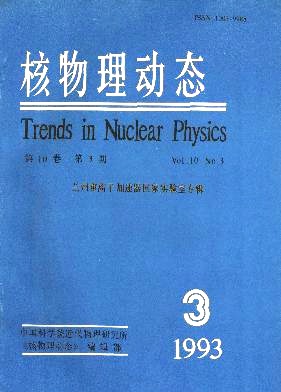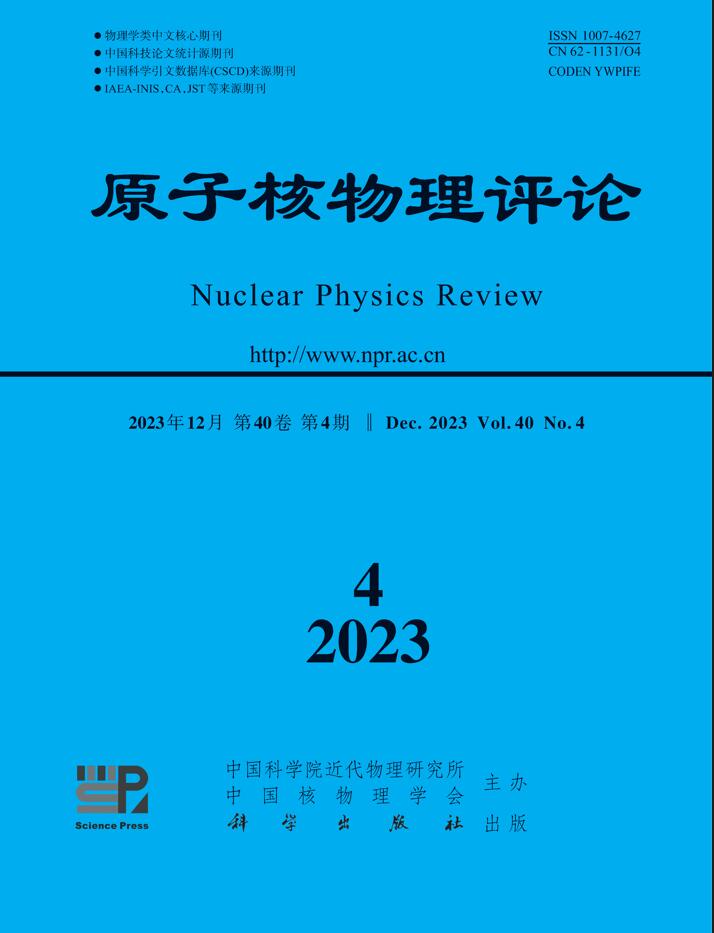1993 Vol. 10, No. 3

Display Method:
1993, 10(3): 2-6.
doi: 10.11804/NuclPhysRev.10.03.002
Abstract:
This paper reports on the current status of operation and development of the Heavy IonResearch Facility in Lanzhou (HIRFL), and introduces briefly the outline of the scientific activities inNLHIAL. In addition, a proposal concerning building a Cooler Storage Ring (CSR) for heavy ions incombination with HIRFL is presented.
This paper reports on the current status of operation and development of the Heavy IonResearch Facility in Lanzhou (HIRFL), and introduces briefly the outline of the scientific activities inNLHIAL. In addition, a proposal concerning building a Cooler Storage Ring (CSR) for heavy ions incombination with HIRFL is presented.
1993, 10(3): 7-14.
doi: 10.11804/NuclPhysRev.10.03.007
Abstract:
The experimental studies and achievements recently made at the Heavy Ion ResearchFacility of Lanzhou(HIRFL) are reviewed with an emphasis on the three research fields: the study of intermediate energy heavy ion collision and properties of hot nuclei, the synthesis and study of nucleifar from stability, and the applications of heavy ions. A research program for the near future is alsobriefly introduced.
The experimental studies and achievements recently made at the Heavy Ion ResearchFacility of Lanzhou(HIRFL) are reviewed with an emphasis on the three research fields: the study of intermediate energy heavy ion collision and properties of hot nuclei, the synthesis and study of nucleifar from stability, and the applications of heavy ions. A research program for the near future is alsobriefly introduced.
1993, 10(3): 15-18.
doi: 10.11804/NuclPhysRev.10.03.015
Abstract:
Scince the first C~(+) beam were extracted from HIRFL (Heavy Ion Research Facility ofLanzhou)on Dec. 12, 1988, C~(+) (50MeV/u, 7SMeV/u), O(+) (50MeV/u), Ne(+) (25MeV/u) Ar(15+)(25MeV/u)and other beams have been accelerated for the testing of the experimental terminals andthe experimental raserach on heavy ion nuclear physics, atomic physics, nuclear chemistry, biologyand material science. The beam emittance is less than 8π mm mrad and the energy spread is less than0.3%. The 10 GHz ECR ion...
Scince the first C~(+) beam were extracted from HIRFL (Heavy Ion Research Facility ofLanzhou)on Dec. 12, 1988, C~(+) (50MeV/u, 7SMeV/u), O(+) (50MeV/u), Ne(+) (25MeV/u) Ar(15+)(25MeV/u)and other beams have been accelerated for the testing of the experimental terminals andthe experimental raserach on heavy ion nuclear physics, atomic physics, nuclear chemistry, biologyand material science. The beam emittance is less than 8π mm mrad and the energy spread is less than0.3%. The 10 GHz ECR ion...
1993, 10(3): 19-21.
doi: 10.11804/NuclPhysRev.10.03.019
Abstract:
The synthesis and identification of the first discovered new nuclide 208Hg on HIRFL(Heavy Ion Research Facility of Lanzhou) were described. In this paper the superiorities, difficultiesas well as the physical and technical line about the synthesis and decay study for the nuclides far fromβ-stability line to be made at HIRFL were discussed.
The synthesis and identification of the first discovered new nuclide 208Hg on HIRFL(Heavy Ion Research Facility of Lanzhou) were described. In this paper the superiorities, difficultiesas well as the physical and technical line about the synthesis and decay study for the nuclides far fromβ-stability line to be made at HIRFL were discussed.
1993, 10(3): 22-25.
doi: 10.11804/NuclPhysRev.10.03.022
Abstract:
The results of the two-proton interferometry from experiment of 46.7 MeV/u ~(12)C+~(58)Ni, ~(115)In, ~(197)Au are discussed in this paper. Influences of nuclear force, coloumb force and fermistatistics on correlation function are investigated. It was found from experiment that the emissionsource radius increase with increasing of the target nuclei size, and decrease with increasing of the sumenergy of the two correlated protons, reflecting the high energy protons come from early stage of thereaction.
The results of the two-proton interferometry from experiment of 46.7 MeV/u ~(12)C+~(58)Ni, ~(115)In, ~(197)Au are discussed in this paper. Influences of nuclear force, coloumb force and fermistatistics on correlation function are investigated. It was found from experiment that the emissionsource radius increase with increasing of the target nuclei size, and decrease with increasing of the sumenergy of the two correlated protons, reflecting the high energy protons come from early stage of thereaction.
1993, 10(3): 26-30.
doi: 10.11804/NuclPhysRev.10.03.026
Abstract:
The projectile fragmentation and its competition with the transfer reactions have beenstudied in the reactions induced by 46.7 MeV/u ~(12)C ion on the ~(58)Ni, ~(115)In and ~(197)Au targets. Thereduced momentum distribution widths of the projectile-like fragments for projectile fragmentationand transfer reactions were extracted from the experimental data respectively. The nuclear temperatureperameters were obtained from the relative populations of the unstable particle emission ...
The projectile fragmentation and its competition with the transfer reactions have beenstudied in the reactions induced by 46.7 MeV/u ~(12)C ion on the ~(58)Ni, ~(115)In and ~(197)Au targets. Thereduced momentum distribution widths of the projectile-like fragments for projectile fragmentationand transfer reactions were extracted from the experimental data respectively. The nuclear temperatureperameters were obtained from the relative populations of the unstable particle emission ...
1993, 10(3): 31-35.
doi: 10.11804/NuclPhysRev.10.03.031
Abstract:
The linear momentum transfer (LMT) and mass distribution of the residues in thecollisions of ~(12)C with ~(Nat)Cu in energy region of 20~46. 2MeV/u were measured by usingrediochemical method. Comparing the LMT in this system with that in other systems, linear dependenceof the maxium LMT for central collision on geometry of target nucleus was obtained, and the averageLMT then depended on the geometry of whole system. Comparision of the mass distribution measured here with theoretical calculation...
The linear momentum transfer (LMT) and mass distribution of the residues in thecollisions of ~(12)C with ~(Nat)Cu in energy region of 20~46. 2MeV/u were measured by usingrediochemical method. Comparing the LMT in this system with that in other systems, linear dependenceof the maxium LMT for central collision on geometry of target nucleus was obtained, and the averageLMT then depended on the geometry of whole system. Comparision of the mass distribution measured here with theoretical calculation...
1993, 10(3): 36-38.
doi: 10.11804/NuclPhysRev.10.03.036
Abstract:
The experimental measurements and results of LMT distribution in ~(12)C(50MeV/u)+~(208)Bi reaction are reported. By using BUU equation for nucleus-nucleus collision process, the dynamicimitation calculation is made. The theoretical calculated LMT distribution is compared with theexperimental one and some discussion has been reviewed.
The experimental measurements and results of LMT distribution in ~(12)C(50MeV/u)+~(208)Bi reaction are reported. By using BUU equation for nucleus-nucleus collision process, the dynamicimitation calculation is made. The theoretical calculated LMT distribution is compared with theexperimental one and some discussion has been reviewed.
1993, 10(3): 39-42.
doi: 10.11804/NuclPhysRev.10.03.039
Abstract:
The velocities and angles of fission partners emitted from reactions in ~(12)C+~(159)Tb, ~(197)Au,~(209)Bi systems with bombarding energy of 46.7MeV/u are measured. The linear momentum transferfrom projectile to target、mass and out-of-reaction plane angle distributions of fission fragments arestudied, and the temperatures of the target residues are extracted. These results have been explained by statistical binary decay model. It seems that the compound-likesystem with high temperature...
The velocities and angles of fission partners emitted from reactions in ~(12)C+~(159)Tb, ~(197)Au,~(209)Bi systems with bombarding energy of 46.7MeV/u are measured. The linear momentum transferfrom projectile to target、mass and out-of-reaction plane angle distributions of fission fragments arestudied, and the temperatures of the target residues are extracted. These results have been explained by statistical binary decay model. It seems that the compound-likesystem with high temperature...
1993, 10(3): 43-47.
doi: 10.11804/NuclPhysRev.10.03.043
Abstract:
The researches with Radioactive Nucleon Beam (RNB) at HIRFL is proposed as threestages. 1) Modification of post beam transport line as Projectile Fragmentation (PF) type RNB underconstruction. 2) High quality (PF) RNB being designed. 3) Storage ring (with accelerating ability) isperspective. Meantime, the progress of 1st stage RNB at HIRFL is described.
The researches with Radioactive Nucleon Beam (RNB) at HIRFL is proposed as threestages. 1) Modification of post beam transport line as Projectile Fragmentation (PF) type RNB underconstruction. 2) High quality (PF) RNB being designed. 3) Storage ring (with accelerating ability) isperspective. Meantime, the progress of 1st stage RNB at HIRFL is described.
1993, 10(3): 48-52.
doi: 10.11804/NuclPhysRev.10.03.048
Abstract:
The radiation effects were studied by means of PAT, CEMS, SEM and TEM in nickel,martensitic ageing stainless steel, ferrite steel HT-9 and stainless steel 316L induced by carbon ionswith energy of tens of MeV to hundreds of MeV delivered by HIRFL. It includes segregate,preciptale, phase change and void swelling, as well as temperature-relativity of the irradiationswelling. The damage distribution was also studied in nickel irradiated by 510MeV C~(6+). And the recentresults of Ar ions ...
The radiation effects were studied by means of PAT, CEMS, SEM and TEM in nickel,martensitic ageing stainless steel, ferrite steel HT-9 and stainless steel 316L induced by carbon ionswith energy of tens of MeV to hundreds of MeV delivered by HIRFL. It includes segregate,preciptale, phase change and void swelling, as well as temperature-relativity of the irradiationswelling. The damage distribution was also studied in nickel irradiated by 510MeV C~(6+). And the recentresults of Ar ions ...
1993, 10(3): 53-55.
doi: 10.11804/NuclPhysRev.10.03.053
Abstract:
The vacancies and vacancy clusters induced by the irradiation lead to the change of themagnetic structure around the defects. The reduction of the hyperfine magnetic field is caused by thelower superexchange field due to the formation of the O~(2-) vacancies. The change of direction of thehyperfine field has been also observed in Mossbauer spectra. On the other hand, the X-raydiffraction showed that the defects give rise to an increase of the lattice constant of the samples.
The vacancies and vacancy clusters induced by the irradiation lead to the change of themagnetic structure around the defects. The reduction of the hyperfine magnetic field is caused by thelower superexchange field due to the formation of the O~(2-) vacancies. The change of direction of thehyperfine field has been also observed in Mossbauer spectra. On the other hand, the X-raydiffraction showed that the defects give rise to an increase of the lattice constant of the samples.
1993, 10(3): 56-60.
doi: 10.11804/NuclPhysRev.10.03.056
Abstract:
We have investigated the excitation processes in collisions between N~(6+), O~(5+), Ne~(4+) andHe by using the ECR ionic source and the LHT-30 VUV Monochromator. The emission spectra showthat there are three channels of excitation in the N~(6+)+He collision system: (1) Single electroncapture into excited states; (2) Double electron capture into excited states; (3) Direct excitation ofincident ions.
We have investigated the excitation processes in collisions between N~(6+), O~(5+), Ne~(4+) andHe by using the ECR ionic source and the LHT-30 VUV Monochromator. The emission spectra showthat there are three channels of excitation in the N~(6+)+He collision system: (1) Single electroncapture into excited states; (2) Double electron capture into excited states; (3) Direct excitation ofincident ions.
1993, 10(3): 61-64.
doi: 10.11804/NuclPhysRev.10.03.061
Abstract:
The biological effects of 46.6MeV/u ~(12)C~(6+) ions on four kinds of plant seeds were studiedat HIRFL of Institute of Modern Physics (IMP), Academia Sinica. The results indicate that seriousinjuries were presented on not only external features of the seeds but also internal cells due to the bombardment and penetration of the ions. The heavy ions can significantly inhibitgermination and growth of the seeds and can affect physiological functions. In root tip cells ofirradiated seeds...
The biological effects of 46.6MeV/u ~(12)C~(6+) ions on four kinds of plant seeds were studiedat HIRFL of Institute of Modern Physics (IMP), Academia Sinica. The results indicate that seriousinjuries were presented on not only external features of the seeds but also internal cells due to the bombardment and penetration of the ions. The heavy ions can significantly inhibitgermination and growth of the seeds and can affect physiological functions. In root tip cells ofirradiated seeds...
1993, 10(3): 65-66.
doi: 10.11804/NuclPhysRev.10.03.065
Abstract:
Some source modifications and tests before and after installing the source to SFC beamline are reported. A preliminary study on an electron gun with cold cathode used in CAPRICE typeECR source is presented.
Some source modifications and tests before and after installing the source to SFC beamline are reported. A preliminary study on an electron gun with cold cathode used in CAPRICE typeECR source is presented.
1993, 10(3): 67-68.
doi: 10.11804/NuclPhysRev.10.03.067
Abstract:
The new structure of SFC centre region is described. After an ECRIS was used, a spiralinflector had been assembled at the centre of the machine. The magnetic plog and the Dee electrodewere modified. The current of the first beam ~(40)Ar~(8+) sent to HIRFL is more than 1.2μA.
The new structure of SFC centre region is described. After an ECRIS was used, a spiralinflector had been assembled at the centre of the machine. The magnetic plog and the Dee electrodewere modified. The current of the first beam ~(40)Ar~(8+) sent to HIRFL is more than 1.2μA.
1993, 10(3): 69-72.
doi: 10.11804/NuclPhysRev.10.03.069
Abstract:
CSR, a heavy ion Cooler Storage Ring, is a new proposal which is intended toconsummate HIRFL. The circumference of the ring is ~(141)m and a six-fold symmetry type withinserting two long straight sections is adopted in the distribution of the ring. CSR is a multipurpose ringwith two essential operating modes of synchrotron and cooler, and will accelerate the particles up to1Gev/u for light heavy ions(Z/A=1/2) and 500MeV/u for heavy ions(Z/A=1/3) by using theexisting two cyclotrons SFC (K=69)...
CSR, a heavy ion Cooler Storage Ring, is a new proposal which is intended toconsummate HIRFL. The circumference of the ring is ~(141)m and a six-fold symmetry type withinserting two long straight sections is adopted in the distribution of the ring. CSR is a multipurpose ringwith two essential operating modes of synchrotron and cooler, and will accelerate the particles up to1Gev/u for light heavy ions(Z/A=1/2) and 500MeV/u for heavy ions(Z/A=1/3) by using theexisting two cyclotrons SFC (K=69)...







 甘公网安备 62010202000723号
甘公网安备 62010202000723号